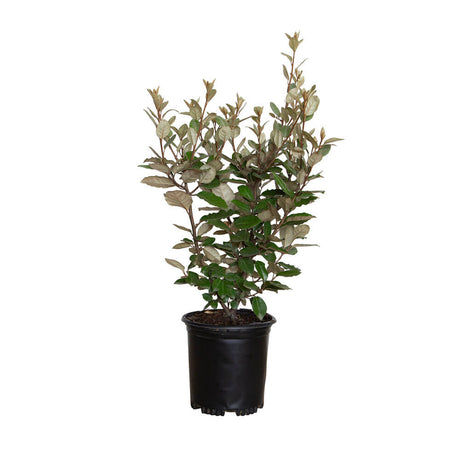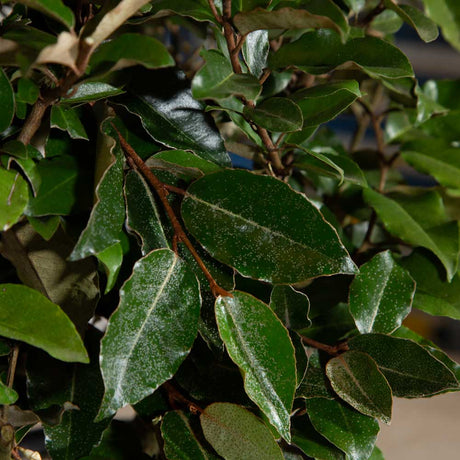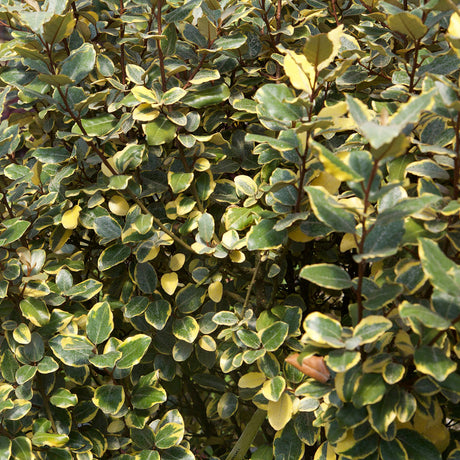FiltersFilter & Sort
Flowerwood
Elaeagnus ebbingei (Ebbinge's Silverberry)
From $18.49Unit price /UnavailableIn stock (245)Southern Living Plant Collection
From $37.98Unit price /UnavailableIn stock (683)
Elaeagnus, also known as Silverberry, is a diverse species of assorted shrubs and trees that originate from Asia, Australia, and North America. As a group, they're known for their characteristic silvery scaled foliage and tangy fruit. Today's gardeners find numerous cultivars of this species available for various landscaping niches. We offer two of our favorite varieties that are fantastic additions to any landscape!
Why Should I Plant Elaeagnus?
There are several compelling reasons to plant some of these guys in your landscape.
Many varieties are fast-growing
This makes them a great choice if you're looking for a speedy privacy shrub or want to fill a spot quickly. In favorable conditions, they'll grow over 20 inches every year! However, they also respond well to trimming, so you can easily keep them at your desired size once they get there.
Elaeagnus plants are nitrogen-fixers
Their roots provide favorable habitats for nitrogen-fixing organisms. These microscopic creatures make nitrogen (a valuable component for plant growth) available for the plant. Therefore, they're able to thrive in soils that have poor nitrogen content or are just poor quality in general.
Their foliage is naturally dense
Despite their speedy growth, these guys have very compact foliage. Their leaves and branches are plentiful and spaced closely. So you don't need to worry about any prying eyes making it through your fast-growing privacy hedge. They do this without any pruning. However, trimming will make them even denser.
Where Should I Plant Them?
Elaeagnus grows well in Full Sun as well as Partial Shade. So simply avoid planting them in a location that has heavy shade and they should do well. They prefer their soil to be slightly acidic and with decent drainage. They handle neutral soil as well. Highly alkaline planting locations may be an issue over time. Slow-drainage soil can also create problems over time. We recommend mixing your native soil with pine bark at a ratio of about 1:1 if it drains slowly. They're great for property line plantings or building corners because of their larger size and fast-growth. Plant some shorter blooming plants in front of them for a really dynamic display. We recommend Gardenias, Azaleas, or Camellias because they like similar planting conditions to Elaeagnus.
When Should I Plant?
Mid-spring and early fall are the most ideal times to plant these shrubs. However, within the growing zones that they thrive in, they are pretty resilient. Most gardeners can have success with planting them in Summer or mid-late Fall if they keep an eye on them during times of extreme temperatures. Cover them overnight during hard-freezes and water them more often during extended heat/drought periods.
How To Plant Elaeagnus
- First, determine a suitable planting location for your plant(s).
- Dig a hole that is roughly 3 times as wide as the pot that your plant came in.
- This makes it easier for your new plant’s roots to spread.
- The hole only needs to be deep enough that your plant sits even with the natural ground around it.
- Mix your native soil with some rich gardening soil, composted manure, or soil conditioner.
- Mix with pine bark for clay soil and/or areas with slow drainage.
- Backfill the hole with your soil mixture and gently pat the soil down around the plant with your hands.
- Now is also a good time to fertilize your plant. For this species, we recommend a slow-release fertilizer for acid-loving plants. However, avoid using liquid fertilizer on new plantings.
- Soak the plant and soil with a hose to hydrate it and settle everything into the planting location.
About Our Varieties
We offer two standout selections that are both hybrids of the same breed, Elaeagnus x Ebbingei. Another name for them is Ebbinge's Silverberry. We offer the traditional cultivar and another cultivar called the Olive Martini. Both are quality plants in their own right. The traditional Ebbinge's Silverberry received the Royal Horticultural Society's Award of Garden Merit. It has silver grey-green leaves and produces tangy and sweet silvery-orange to red berries that ripen in early spring. It has a more bushy growth habit and can reach 8-10 feet high and wide. The Olive Martini Elaeagnus is from the Southern Living Plant Collection. It has gorgeous variegated golden and dark green foliage. It grows more upright than the classic Silverberry. This is a great substitute for Golden Euonymus if you're looking for something similar but a bit more unusual and with a bolder color. This cultivar does not typically have berries, but it can on occasion.
Why Buy Plants from Us?
We're choosy about the plants that we ship to our customers. We guarantee that they'll be well-matured into their pots and ready to grow in your landscape. All of our plants are shipped in the pots they were grown in, never bare-root. If you're unhappy with your order, give us a call at 1-866-618-5659 or send us an email at info@plantsbymail.com. We'll get back with you as soon as possible.













